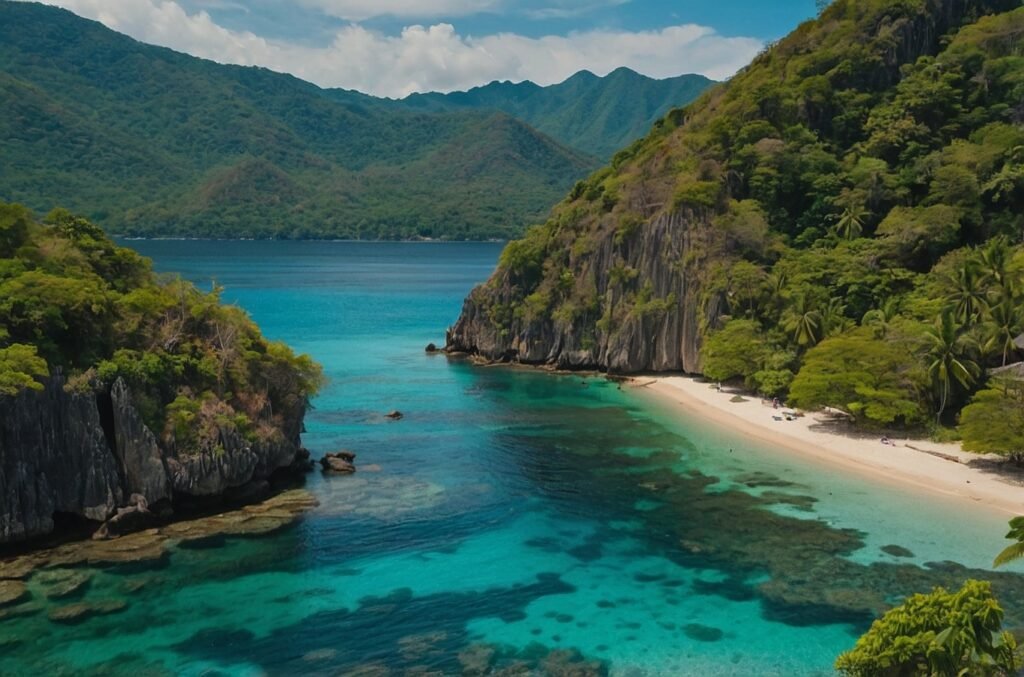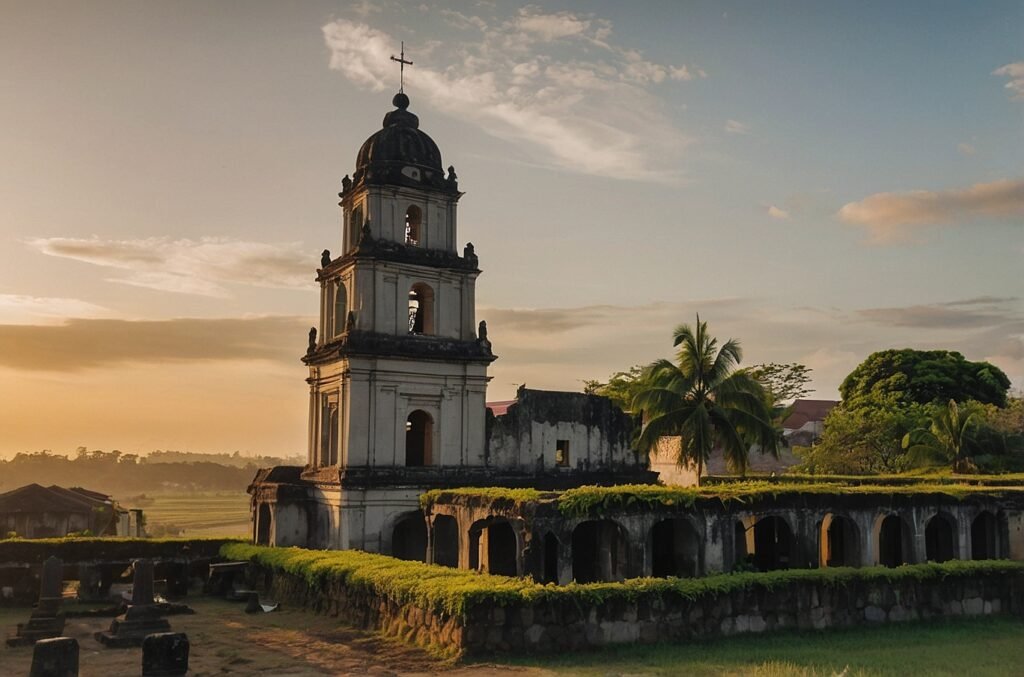Nestled in the heart of the Philippines’ Calabarzon region, Batangas is a coastal province that beckons travelers with its pristine beaches, vibrant marine life, and rich cultural heritage. Just a few hours’ drive from the bustling metropolis of Manila, this hidden gem offers a perfect escape for those seeking sun, sand, and sea. But Batangas is more than just a beach destination – it’s a place where history, nature, and adventure intertwine to create an unforgettable experience.
As we embark on this virtual journey through Batangas, we’ll explore its diverse attractions, from world-class diving spots to historical landmarks, and uncover the secrets that make this province a must-visit destination for both local and international tourists. So, grab your sunscreen and let’s dive into the wonders of Batangas!
A Brief History: From Ancient Settlements to Spanish Colonial Era
The Origins of Batangas
The story of Batangas stretches back centuries, with evidence of human settlements dating as far back as the 10th century. The province’s name is believed to have originated from the word “batang,” which refers to the numerous logs found in the Calumpang River, the body of water that runs through the provincial capital.
Before the arrival of the Spanish colonizers, Batangas was already a thriving community, with its inhabitants engaged in agriculture, fishing, and trade. The province’s strategic location along the coast made it an important hub for commerce and cultural exchange.
Spanish Colonial Influence
The Spanish colonial era left an indelible mark on Batangas, shaping its culture, architecture, and religious practices. The province became one of the first Spanish settlements in the Philippines, with the establishment of the town of Taal in 1572. Over the centuries, Batangas played a significant role in the country’s struggle for independence, producing notable heroes and revolutionaries.
Today, visitors can still witness the remnants of this colonial past in the form of centuries-old churches, ancestral houses, and historical sites scattered throughout the province. These architectural treasures serve as a testament to Batangas’ rich and colorful history.
Geography and Climate: A Diverse Landscape
Topography and Natural Features
Batangas boasts a diverse landscape that encompasses everything from pristine coastlines to rolling hills and majestic mountains. The province covers an area of approximately 3,119 square kilometers and is bounded by the provinces of Cavite and Laguna to the north, Quezon to the east, and the Verde Island Passage to the south.
One of the most prominent geographical features of Batangas is the Taal Volcano, the world’s smallest active volcano, situated within Taal Lake. This unique volcano-within-a-lake-within-a-volcano formation is not only a geological wonder but also a major tourist attraction.
Climate and Best Time to Visit
Batangas enjoys a tropical climate characterized by two distinct seasons: the dry season from November to April and the wet season from May to October. The province experiences an average annual temperature of around 28°C (82°F), making it an ideal year-round destination for beach lovers and outdoor enthusiasts.
Here’s a breakdown of the average monthly temperatures and rainfall in Batangas:
| Month | Average Temperature (°C) | Average Rainfall (mm) |
|---|---|---|
| January | 26 | 39 |
| February | 26 | 19 |
| March | 27 | 23 |
| April | 28 | 30 |
| May | 29 | 154 |
| June | 28 | 265 |
| July | 27 | 325 |
| August | 27 | 334 |
| September | 27 | 297 |
| October | 27 | 234 |
| November | 27 | 157 |
| December | 26 | 81 |
While Batangas can be visited year-round, the best time to plan your trip is during the dry season, particularly from December to May. This period offers the most favorable weather conditions for beach activities, diving, and outdoor exploration. However, if you don’t mind occasional showers and want to avoid the peak tourist season, visiting during the shoulder months of June and November can also be rewarding.
The Beaches of Batangas: Sun, Sand, and Serenity
Laiya: White Sand Paradise
When it comes to beaches in Batangas, Laiya stands out as a true gem. Located in the municipality of San Juan, Laiya boasts a long stretch of white sand beaches that rival those of more famous destinations like Boracay. The crystal-clear waters and gentle waves make it perfect for swimming, while the surrounding lush vegetation provides a picturesque backdrop.
Laiya offers a range of accommodations, from budget-friendly resorts to luxurious beachfront villas, catering to all types of travelers. Whether you’re looking for a romantic getaway or a family-friendly vacation spot, Laiya has something for everyone.
Nasugbu: A Beach Lover’s Haven
Nasugbu, situated on the western coast of Batangas, is another popular beach destination that shouldn’t be missed. The town is home to several stunning beaches, each with its own unique charm. Some of the must-visit beaches in Nasugbu include:
- Fortune Island: An abandoned resort island known for its Greek-inspired ruins and excellent snorkeling spots.
- Punta Fuego: A private beach resort offering exclusivity and world-class amenities.
- Tali Beach: A secluded stretch of sand perfect for those seeking tranquility and unspoiled beauty.
Anilao: Gateway to Underwater Wonders
While Anilao is primarily known for its diving spots (which we’ll explore in more detail later), it also boasts some beautiful beaches that are worth exploring. The coastline of Anilao is dotted with small coves and rocky shores, offering a more rugged and natural beach experience compared to the white sand beaches of Laiya and Nasugbu.
Many resorts in Anilao have their own private beaches, allowing guests to enjoy a more intimate and exclusive beach experience. Even if you’re not a diver, Anilao’s beaches provide excellent opportunities for snorkeling, kayaking, and simply soaking up the sun.
Diving in Batangas: Exploring the Underwater Paradise
Anilao: The Dive Capital of the Philippines
Anilao, located in the municipality of Mabini, has earned its reputation as the “Dive Capital of the Philippines” for good reason. This small coastal town is a paradise for underwater enthusiasts, offering some of the best diving and snorkeling experiences in the country. What makes Anilao truly special is its incredible biodiversity and the accessibility of its dive sites.
The waters surrounding Anilao are part of the Coral Triangle, an area known for its rich marine ecosystem. Divers can expect to encounter a wide variety of marine life, including:
- Colorful coral reefs
- Nudibranchs (sea slugs) in all shapes and sizes
- Various species of tropical fish
- Sea turtles
- Occasional sightings of larger marine animals like whale sharks and manta rays
Popular Dive Sites in Anilao
Anilao boasts over 40 dive sites catering to divers of all skill levels. Here are some of the most popular spots:
- Twin Rocks: A beginner-friendly site known for its abundant marine life and two distinctive rock formations.
- Beatrice Rock: Famous for its macro life, including rare species of nudibranchs and frogfish.
- Mainit Point: A challenging dive site with strong currents, offering the chance to see larger pelagic species.
- Secret Bay: A muck diving paradise where patient divers can spot unique critters like ghost pipefish and flamboyant cuttlefish.
- Kirby’s Rock: Known for its beautiful soft corals and the possibility of encountering sea snakes.
Diving Seasons and Conditions
While diving is possible year-round in Anilao, the best conditions are generally found during the dry season from November to May. During this period, visibility is at its best, often reaching up to 30 meters (100 feet). Water temperatures range from 26°C to 30°C (79°F to 86°F), making it comfortable for diving with a 3mm wetsuit.
For those new to diving, Anilao offers numerous dive shops and resorts that provide PADI and SSI certification courses. Even if you’re not a certified diver, many operators offer introductory dives or snorkeling trips, allowing everyone to experience the underwater wonders of Batangas.
Beyond the Beaches: Exploring Batangas’ Cultural and Historical Sites
Taal Heritage Town: A Step Back in Time
While Batangas is famous for its beaches and diving spots, the province also boasts a rich cultural heritage waiting to be explored. One of the best places to immerse yourself in Batangas’ history is the town of Taal. Declared a National Historical Landmark in 1987, Taal Heritage Town is home to well-preserved Spanish colonial architecture and centuries-old churches.
As you stroll through the cobblestone streets of Taal, you’ll feel like you’ve been transported back to the 19th century. Some must-visit sites in Taal include:
- Basilica of St. Martin of Tours: Known as the largest church in Asia, this imposing structure dominates the town’s skyline.
- Ancestral Houses: Many of Taal’s old houses have been converted into museums, showcasing the lifestyle of the Filipino elite during the Spanish colonial era.
- Galleria Taal: A museum dedicated to vintage cameras and photographs, offering a unique glimpse into the history of photography in the Philippines.
Taal Volcano: A Natural Wonder
No visit to Batangas would be complete without experiencing the awe-inspiring Taal Volcano. As mentioned earlier, Taal is the world’s smallest active volcano, sitting in the middle of Taal Lake. The volcano and its surroundings offer numerous activities for visitors:
- Volcano Trekking: Hike to the crater of Taal Volcano for breathtaking views of the lake and surrounding landscape.
- Boat Tours: Take a scenic boat ride across Taal Lake to reach the volcano island.
- Horseback Riding: Explore the volcano’s slopes on horseback for a unique perspective.
Note: Always check the current volcanic activity status and follow safety guidelines before planning a visit to Taal Volcano.
Batangas City: Urban Exploration
As the capital of the province, Batangas City offers a blend of modernity and history. While it may not be as popular among tourists as the beach destinations, the city has its own charm and attractions worth exploring:
- Batangas Provincial Capitol: A beautiful neoclassical building that serves as the seat of the provincial government.
- Sta. Rita de Cascia Parish Church: A historic church known for its stunning architecture and religious significance.
- Museo ng Batangas: A museum showcasing the province’s rich cultural heritage through artifacts, photographs, and interactive exhibits.
Culinary Delights: Savoring the Flavors of Batangas
Local Specialties
Batangas is not only a feast for the eyes but also for the taste buds. The province is known for several culinary specialties that reflect its rich cultural heritage and abundant natural resources. Some must-try dishes include:
- Bulalo: A hearty beef soup made with bone marrow, vegetables, and corn. Perfect for cool evenings by the beach.
- Lomi: A thick noodle soup filled with various meats and vegetables, often served as a comforting snack or meal.
- Kapeng Barako: A strong, full-bodied coffee grown in the highlands of Batangas, known for its distinct aroma and flavor.
- Gotong Batangas: A savory soup made with beef tripe and innards, flavored with annatto seeds and various spices.
Food Tourism
For food enthusiasts, Batangas offers numerous opportunities to explore its culinary scene:
- Local Markets: Visit the public markets in towns like Lipa and Tanauan to experience the vibrant food culture and sample fresh local produce.
- Food Tours: Join organized food tours that take you to hidden gems and local eateries off the beaten path.
- Cooking Classes: Some resorts and local establishments offer cooking classes where you can learn to prepare traditional Batangueño dishes.
Getting There and Getting Around: Travel Tips for Batangas
How to Reach Batangas
Batangas is easily accessible from Manila and other parts of Luzon. Here are the main ways to reach the province:
- By Car: The South Luzon Expressway (SLEX) and STAR Tollway provide a smooth drive from Manila to Batangas. The journey takes about 2-3 hours, depending on your specific destination within the province.
- By Bus: Several bus companies operate regular routes from Manila to various towns in Batangas. This is a cost-effective option for budget travelers.
- By Van: UV Express vans offer a faster and more comfortable alternative to buses, with frequent departures from Manila to Batangas towns.
Getting Around Batangas
Once in Batangas, you have several options for moving between towns and attractions:
- Jeepneys: These iconic Filipino public utility vehicles are a cheap and authentic way to travel short distances.
- Tricycles: Ideal for short trips within towns and cities.
- Rent-a-Car: For more flexibility, consider renting a car or motorcycle to explore the province at your own pace.
- Boat Tours: To visit islands and coastal attractions, join organized boat tours or hire private boats from local operators.
Sustainable Tourism: Preserving Batangas’ Natural Beauty
As Batangas continues to grow as a tourist destination, it’s crucial to consider the impact of tourism on the local environment and communities. Here are some ways you can practice sustainable tourism during your visit:
- Choose Eco-Friendly Accommodations: Look for resorts and hotels that implement sustainable practices, such as waste reduction and energy conservation.
- Respect Marine Life: When diving or snorkeling, avoid touching or stepping on coral reefs, and never feed or chase marine animals.
- Reduce Plastic Waste: Bring reusable water bottles, bags, and utensils to minimize single-use plastic consumption.
- Support Local Communities: Buy souvenirs from local artisans and dine at locally-owned restaurants to contribute to the local economy.
- Volunteer: Consider participating in beach clean-ups or conservation projects during your stay.
Your Batangas Adventure Awaits
Batangas truly offers something for everyone – from sun-soaked beaches and world-class diving spots to historical landmarks and culinary delights. Whether you’re seeking adventure, relaxation, or cultural immersion, this coastal province has it all. As you plan your trip to Batangas, remember to embrace the local culture, respect the environment, and create memories that will last a lifetime.
So, pack your bags, grab your snorkel, and get ready to explore the wonders of Batangas. Who knows? You might just find yourself falling in love with this beautiful corner of the Philippines and planning your next visit before you even leave!
Disclaimer: The information provided in this blog post is based on research and personal experiences. While we strive for accuracy, details may change over time. We encourage readers to verify current information, especially regarding travel requirements and safety guidelines, before planning their trip. If you notice any inaccuracies, please report them so we can correct them promptly.




